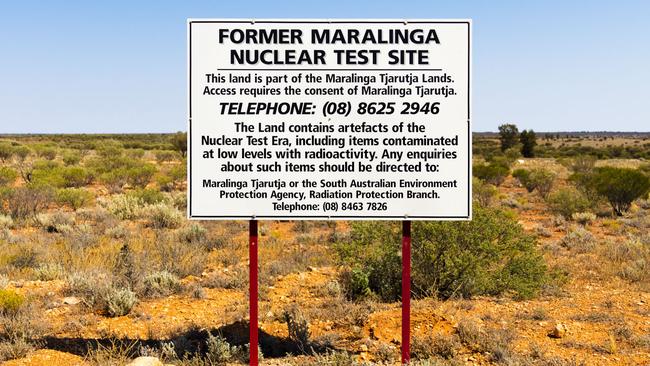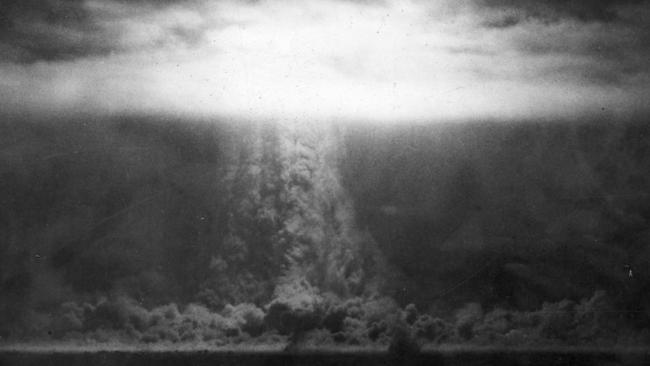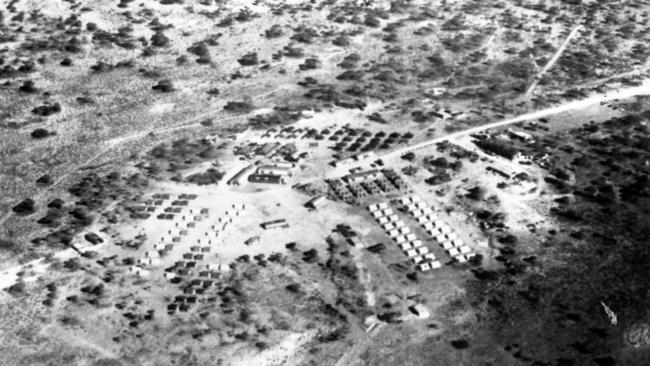New generations of Australian families suffering deformities and early deaths because of ‘genetic transfer’
GENERATIONS of Australians have suffered tumours, missing bones and early deaths. New documents reveals the full horror.
EXCLUSIVE
PEOPLE who worked at Australian atomic bomb test sites claim they have produced generations of children with severe deformities and suffered a high number of stillbirths.
Documents obtained exclusively by news.com.au show hundreds of children and grandchildren of veterans exposed to radiation were born with shocking illnesses including tumours, Down syndrome, cleft palates, cerebral palsy, autism, missing bones and heart disease.
One veteran, who was posted to the Maralinga nuclear test site in South Australia in the 1950s as part of the British Nuclear Test (BNT) program, says the radiation contaminated his sperm and is to blame for the death of a child he never got to know.
But he is not alone, with the documents detailing a litany of miscarriages and stillbirths that has allegedly passed the devastation from generation to generation.
Australian ex-servicemen and their families originally made submissions to a Federal Government review in 2003 over deaths and disabilities they believe were caused by exposure to radiation from nuclear testing in South Australia and Western Australia in the 1950s and 60s.
The submissions were later compiled to use in a class action against the British Ministry of Defence, but the case was not allowed to proceed because it was deemed impossible to prove radiation caused their illnesses.
The Department of Veterans’ Affairs told news.com.au it had not received any reports about Australian descendants of BNT veterans who suffered deformities, abnormalities, illness or death as a result of suspected genetic transfers.
The documents provided to news.com.au reveal that about 100 of the soldiers’ descendants, born as recently as the 1990s, suffered health complications suspected by the families to have been caused by genetic transfers.
“Daughter Stephanie SEVERELY disabled — born with MISSING vertebrae and confined to wheelchair for her entire life,” one entry read.
“Daryl — deformities, back, extra bone, lower back missing bones, deformed jaw, undescended testicles,” another read.
“Birth deformities (neck fusion) ... no anus,” others said.
In many cases, siblings each suffered unique medical problems.
“Gregory — visual abnormalities; Graeme — reduplication of large bowel; Stephen — dental deformities,” one submission read.
Another submission revealed that “all three daughters (of one veteran suffered) numerous cases — ovarian tumours, lymphoma, breast cancer secondaries in bones, 14 inches (35cm) of bowel removed”.
Some of the veterans’ grandchildren were also affected, with reports of one young boy who lost his leg to cancer and another who was born with a cleft palate, according to the submissions.
Many of the descendants died early deaths.
“Son died aged 36 from non-Hodgkins Lymphoma,” one entry read.
“Wife delivered stillborn 1958, daughter Kay delivered stillborn September 2007,” another wrote.
“Son — terminal stomach cancer, dead at 47 years old, both daughters severe Endometriosis, hysterectomy, miscarriage,” another entry revealed.
“… daughter Maree died 24 hours after birth, cause unknown,” another said.


WEARING JUST A HAT AND SHORTS WHEN EXPOSED TO RADIATION
Australian Ex Services Atomic Survivors Association secretary Jim Marlow told news.com.au he was aware of “many” cases where the offspring of BNT veterans died young or were born with severe deformities.
“You hear of it all of the time but a lot of the blokes (affiliated with the association) who had those kids have since died so they’d be hard to track down,” he said.
Canberra retiree Alan Batchelor, 86, was posted to Maralinga in July 1957 as second in command of the engineer group as part of the BNT program.
Seven atomic bombs were detonated by the British government in Maralinga on land that remained radioactive for decades but has since been handed back to traditional owners.
Like many soldiers at the time, Mr Batchelor was wearing just a hat, shorts and boots, when he was exposed to radioactive fallout at Maralinga. Other servicemen suffered the same fate in Emu Field, South Australia, and Monte Bello Islands, off the Western Australia coast, a few years earlier. They were never told of the risks they faced and many went on to suffer radiation sickness and other illnesses.
Of the 8000 Australian personnel who worked in the nuclear testing program, less than a quarter are understood to still be alive.
Today, Mr Batchelor is dying from an auto-immune condition he is adamant was caused by his exposure to radiation. But he has been dealing with the effects of the atomic testing ever since he was discharged from Maralinga, according to him.
STILLBORN BABY AFTER RETURNING FROM MARALINGA
Mr Batchelor believes his exposure to the radiation contaminated his sperm and is to blame for the death of a child he never got to know and the health complications of his surviving offspring.
Mr Batchelor said within 12 months of returning from Maralinga his wife Marion gave birth to a deformed, stillborn baby.
“It was a very bad miscarriage,” he said.
Mr Batchelor’s doctor ordered tests but, according to the veteran, the hospital destroyed his medical records and he was quickly posted interstate by the military.
“I’m pretty sure the tests showed deformities in the sperm and they didn’t want me to know it,” he said.
Nine years after the miscarriage, Mr and Mrs Batchelor had another two children.
One was born with dental deformities which they believe was caused by genetic transfer.
Their other son suffers from mental health issues, which they also believe could be linked.
“There’s no way to prove it so we’ll never really know,” Mr Batchelor said.
“But this type of thing happened to a lot of people and we’ve always felt certain it was what caused (our family’s health issues).”
The couple’s first son was born before Mr Batchelor was posted to Maralinga and has always been healthy, according to his parents.
A Department of Veterans’ Affairs spokesman told news.com.au that studies into the descendants of Hiroshima and Nagasaki nuclear bombs survivors showed they “do not have an increased frequency of chromosome abnormalities or major birth defects”.
“The children also do not have elevated mortality rates, in either childhood or adulthood, nor higher cancer incidence rates,” the spokesman said.
“This suggests that there is no significant danger of ongoing health effects for the descendants of participants in the BNT program.
“While not specifically examining the children of Australian participants in the British nuclear tests, these studies add to our understanding of the intergenerational effects of radiation.”
He said a lack of “scientific evidence to date of genetic transfer” was the reason the government had not provided compensation to claimants.
The complications suffered by many of the descendants referenced in the submissions obtained by news.com.au are in addition to hundreds more children believed by their families to have died as a result of exposure to radiation fallout or genetic transfers linked to atomic testing in Australia.
The Woomera Cemetery in South Australia contains 23 graves for stillborn babies born in the hospital between December 1953 and September 1968, and a further 46 graves for other children who died around that period, the Adelaide Advertiser previously reported.
The families of the Woomera babies always maintained they were never given an explanation for the deaths, and many were convinced they were linked to the atomic tests in nearby Maralinga.
News.com.au understands the medical records of those 23 stillborn babies remain sealed and held by the National Archives of Australia.

GOVERNMENT DENIES LINK BETWEEN RADIATION EXPOSURE AND ILLNESS
But the link between exposure to radiation at the test sites and subsequent illness of the BNT veterans and their descendants has never been accepted by the Australian Government.
A Department of Veterans’ Affairs study concluded that “only two per cent of participants received more than the current Australian annual dose limit for occupationally exposed persons”.
Those who can prove they sustained an injury or disease related to their service are eligible for compensation under the Safety, Rehabilitation and Compensation Act 1988 (SRCA), and its antecedent Acts.
But BNT veterans told news.com.au they are continually rejected on the grounds that the levels of radiation they were exposed to were “too low” to cause their illnesses.
It’s a stark contrast to a 1999 study for the British Nuclear Test Veterans Association, which found that 30 per cent of the nuclear test veterans had died, mostly in their 50s, from cancers or cancer-related illnesses.
In addition, a 2007 New Zealand study found that New Zealand sailors who had been exposed to the nuclear testing had three times the level of genetic abnormality and notably higher rates of cancer than the general population.
Following a British decision in 1988, the Australian Government negotiated compensation for a small group of Australian servicemen suffering from two specific conditions — leukaemia (except lymphatic leukaemia) and a rare blood disorder known as multiple myeloma.
But the bulk of BNT Australian veterans have never been compensated over radiation exposure during the atomic bomb tests in the 1950s and 60s. Nor have their medical conditions been officially linked to their exposure.
While BNT service personnel have had access to disability pensions and health care under the Veterans’ Entitlements Act 1986 (VEA) since July 1, 2010, and cancer treatments, many of them say they are not entitled to full benefits.
Mr Batchelor said he wasn’t even entitled to a veteran’s gold card despite all he has suffered, sacrificed and lost.
“Those (veterans) that are left could desperately do with a gold card,” he said.
“I don’t think that’s asking for too much.”




